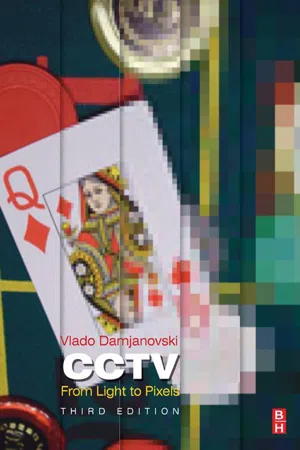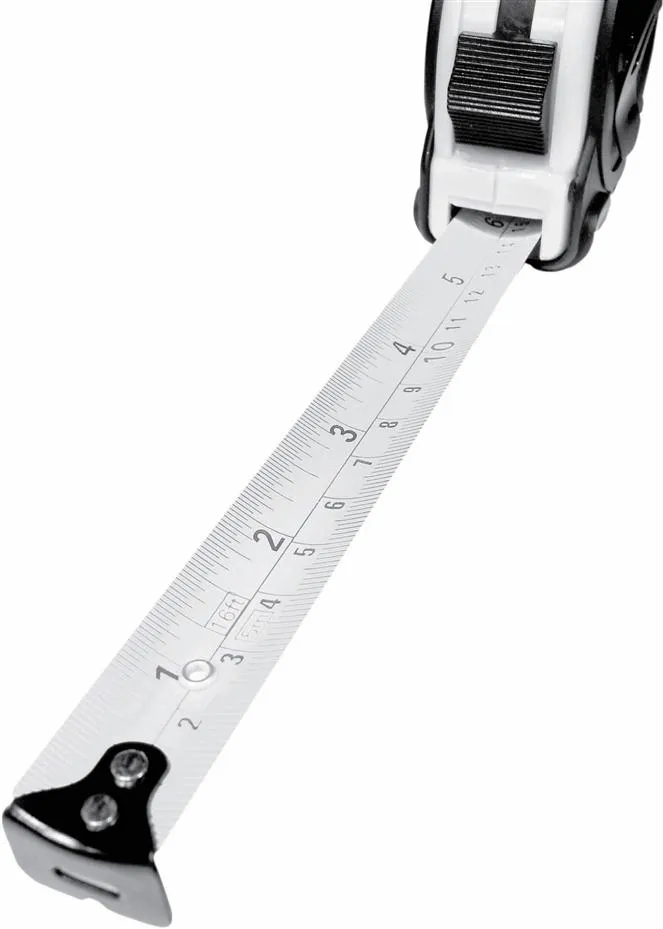
eBook - ePub
CCTV
From Light to Pixels
Vlado Damjanovski
This is a test
- 616 Seiten
- English
- ePUB (handyfreundlich)
- Über iOS und Android verfügbar
eBook - ePub
CCTV
From Light to Pixels
Vlado Damjanovski
Angaben zum Buch
Buchvorschau
Inhaltsverzeichnis
Quellenangaben
Über dieses Buch
The new edition of CCTV, a high-level professional reference, is expanded to cover all video compression techniques used in the ever-increasing assortment of digital video recorders (DVRs) available on the market today. In addition to demystifying DVR technology, the third edition also clarifies the technology of data networking and explains various compression techniques. Along with all this, the book retains the particulars that made the previous editions convenient and valuable, including details of CCD cameras, lenses, coaxial cables, fiber-optics, and system design.
- Updated to address digital techniques, networking, and the Internet in closed-circuit television
- Includes brand new sections on CCTV networking, digital video recorders (DVRs), various video compression techniques, and understanding pixels and digital image quality
- Fully illustrated with dozens of photographs, tables, checklists, charts, diagrams, and instructions
Häufig gestellte Fragen
Wie kann ich mein Abo kündigen?
Gehe einfach zum Kontobereich in den Einstellungen und klicke auf „Abo kündigen“ – ganz einfach. Nachdem du gekündigt hast, bleibt deine Mitgliedschaft für den verbleibenden Abozeitraum, den du bereits bezahlt hast, aktiv. Mehr Informationen hier.
(Wie) Kann ich Bücher herunterladen?
Derzeit stehen all unsere auf Mobilgeräte reagierenden ePub-Bücher zum Download über die App zur Verfügung. Die meisten unserer PDFs stehen ebenfalls zum Download bereit; wir arbeiten daran, auch die übrigen PDFs zum Download anzubieten, bei denen dies aktuell noch nicht möglich ist. Weitere Informationen hier.
Welcher Unterschied besteht bei den Preisen zwischen den Aboplänen?
Mit beiden Aboplänen erhältst du vollen Zugang zur Bibliothek und allen Funktionen von Perlego. Die einzigen Unterschiede bestehen im Preis und dem Abozeitraum: Mit dem Jahresabo sparst du auf 12 Monate gerechnet im Vergleich zum Monatsabo rund 30 %.
Was ist Perlego?
Wir sind ein Online-Abodienst für Lehrbücher, bei dem du für weniger als den Preis eines einzelnen Buches pro Monat Zugang zu einer ganzen Online-Bibliothek erhältst. Mit über 1 Million Büchern zu über 1.000 verschiedenen Themen haben wir bestimmt alles, was du brauchst! Weitere Informationen hier.
Unterstützt Perlego Text-zu-Sprache?
Achte auf das Symbol zum Vorlesen in deinem nächsten Buch, um zu sehen, ob du es dir auch anhören kannst. Bei diesem Tool wird dir Text laut vorgelesen, wobei der Text beim Vorlesen auch grafisch hervorgehoben wird. Du kannst das Vorlesen jederzeit anhalten, beschleunigen und verlangsamen. Weitere Informationen hier.
Ist CCTV als Online-PDF/ePub verfügbar?
Ja, du hast Zugang zu CCTV von Vlado Damjanovski im PDF- und/oder ePub-Format sowie zu anderen beliebten Büchern aus Computer Science & Computer Vision & Pattern Recognition. Aus unserem Katalog stehen dir über 1 Million Bücher zur Verfügung.
Information
1
SI Units of Measurement
Abstract
The Laws of Physics are expressions of fundamental relationships between certain physical quantities. Measurements are made by comparing the magnitude of a quantity with that of a given unit of that quantity. In physics, which Electronics and Television are a part of, the International system of units, known as SI (from the French SystèmeInternationale), is used.
Key Words
basic unit; derived unit; International system of units; metric prefix

The basic units
The laws of physics are expressions of fundamental relationships between certain physical quantities.
There are many different quantities in physics. In order to simplify measurement and to comply with the theory of physics, some of them are taken as basic quantities, while all others are derived from those basic ones.
Measurements are made by comparing the magnitude of a quantity with that of a given unit of that quantity.
In physics, of which electronics and television are a part, the International System of Units, known as SI (from the French Système Internationale), is used.
The following are the seven basic units:
| Unit | Symbol | Measures |
| Meter | [m] | length |
| Kilogram | [kg] | mass |
| Second | [s] | time |
| Ampere | [A] | electric current |
| Kelvin | [K] | temperature |
| Candela | [cd] | luminous intensity |
| Mole | [mol] | amount of substance |
These basic units are defined by internationally recognized standards.
The standard for meter, for example, was defined as a certain number of wavelengths of a specific radiation in the spectrum of krypton until 1983. In October 1983 it was redefined as the distance that light travels in vacuum during a time of 1/299,792,458 second.
The standard of kilogram, for example, is the mass of a particular piece of platinum-iridium alloy cylinder kept at the International Bureau of Weights and Measurements in Sèvres, France.
The basic unit of time, the second, was defined in 1967, as a “time required for a Cesium-133 atom to undergo 9,192,631,770 vibrations.”
Kelvin degrees have the same scale division as Celsius degrees, only that the starting point of 0° K is equivalent to − 273° C; this is called the absolute zero.
All other units in physics are defined with some combination of the above-mentioned basic units. For example, an area of a block of land is defined by the equation:

where a is the width of the block of land, and b is the length. If both a and b are expressed in meters [m], the product P will be expressed in [m2]. We should mention that in mathematics the multiplication is not always represented with the × sign as above, but very often a dot • is used in between the factors being multiplied, or sometimes even without a symbol at all.
We all know that speed, for example, is defined as [m/s], although we quite often use [km/h]. We can easily convert [km/h] into [m/s] by knowing ...
Inhaltsverzeichnis
- Cover image
- Title page
- Table of Contents
- Copyright
- Preface to this edition
- Introduction
- 1. SI Units of Measurement
- 2. Light and Television
- 3. Optics in CCTV
- 4. General About TV Systems
- 5. CCTV Cameras
- 6. Displays
- 7. Analog Video Processing
- 8. Digital CCTV
- 9. Video Management Systems
- 10. Transmission Media
- 11. Networking in CCTV
- 12. Auxiliary Equipment in CCTV
- 13. CCTV System Design
- 14. Video Testing
- Appendix A
- Appendix B
- Appendix C
- Appendix D
- Index
Zitierstile für CCTV
APA 6 Citation
Damjanovski, V. (2013). CCTV (3rd ed.). Elsevier Science. Retrieved from https://www.perlego.com/book/1831366/cctv-from-light-to-pixels-pdf (Original work published 2013)
Chicago Citation
Damjanovski, Vlado. (2013) 2013. CCTV. 3rd ed. Elsevier Science. https://www.perlego.com/book/1831366/cctv-from-light-to-pixels-pdf.
Harvard Citation
Damjanovski, V. (2013) CCTV. 3rd edn. Elsevier Science. Available at: https://www.perlego.com/book/1831366/cctv-from-light-to-pixels-pdf (Accessed: 15 October 2022).
MLA 7 Citation
Damjanovski, Vlado. CCTV. 3rd ed. Elsevier Science, 2013. Web. 15 Oct. 2022.